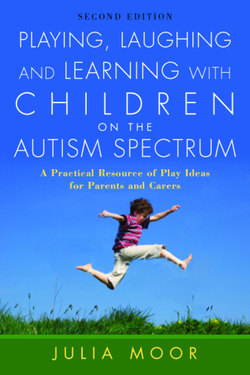Читать книгу Playing, Laughing and Learning with Children on the Autism Spectrum - Julia Moor - Страница 12
На сайте Литреса книга снята с продажи.
Communication
ОглавлениеHow do you create a motivation to communicate?
Observe when your child is most accessible and jot down when these times are. It may be:
when he’s being tickled
when you sing to him
when you play rough-and-tumble
when he’s eating something he really likes
when he’s jumping on the trampoline
when he’s splashing in puddles
when he’s having a bath
when he’s relaxed and in bed.
It may be none of the above but something else, a time when he seems receptive, relaxed and willing to look at you (no matter how fleetingly). It may even be a time that you hadn’t noticed before, such as sitting in the car (ride as a passenger next to him one day and watch his reactions to you), or swinging in the park.
Once you have pinpointed these times, use them as periods when you really work on showing your child that communication with people means something – that it brings its own rewards.
Encourage your child to touch you and create a response that he may find appealing. For example, guide his hand to your face and make a ‘beep beep’ noise when he touches your nose, or put out your tongue. Make the same response every time so that he realizes that the same gesture creates the same response. He may want to repeat the game over and over. When he gets the hang of it, make a new gesture for touching different parts of your face. Touch his face and encourage him to make the noise with you. This may be a good game to play last thing at night when he’s lying in bed, or when he’s in the bath.
When you are engaging in a game he enjoys, such as tickling, stop to take a long pause (often longer than you might feel comfortable with), and wait for your child to make a gesture to indicate he wants the game to continue; this may be by making eye contact or pulling your hands back to him. In response, look back at your child, and say, ‘You want more? – yes?’ and carry on the game.
‘Peek-a-boo’ games – Hold a cushion/cloth up to your face or hide behind objects (a huge box or play tunnel is great). Create lengthy pauses to build up anticipation and to give your child a space to indicate that he wants the game to continue.
Pulling silly faces – Cover your face with your hands and as you take them away change your expression. Try wearing a hat or painting your nose red with lipstick so your child really looks into your face. Encourage eye contact before you change expression.
Dancing – Swing and sway to music with your child, then stop and pause for him to indicate he wants more. (See Chapter 7 for lots of dance/music activities.)
Blowing raspberries onto the palms of his hands/tummy – wait for eye contact before you do it again.
Allow your child to dictate how long he lets you into his space – I found that the moment I attempted to prolong an activity and force my attention on my son, then that particular activity ceased to have an appeal to him.
Once you are familiar with how your child responds when he attempts to communicate, look for more and more ways to access him and more opportunities for him to interact with you.
